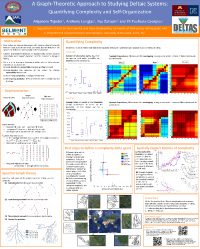CSDMS 2015 annual meeting poster AlejandroTejedor
A graph-theoretic approach to Studying Deltaic Systems: Quantifying Complexity and Self-Organization.
Anthony Longjas, University of Minnesota, Minnesota, United States.
Ilya Zaliapin, University of Reno, Nevada, United States.
Efi Foufoula-Georgiou, University of Minnesota, Minnesota, United States.
Abstract:
River deltas are intricate landscapes with complex channel networks that self-organize to deliver water, sediment, and nutrients from the apex to the delta top and eventually to the coastal zone. Most of the deltas are subject to anthropogenic and natural perturbations causing topological and dynamical changes in the delta structure and function. Conceptualizing a delta channel network as a directed graph where channels are modeled by edges and junctions by vertices, we present a quantitative framework based on spectral graph theory within which a systematic study of the topology and transport dynamics of river deltas can be performed. Specifically, this framework allows us, from algebraic computations, to depict structural features of the delta system such as sub-networks (from apex to shoreline outlets), and contributing and nourishing areas. We also introduce metrics of topologic and dynamic complexity and define a multidimensional complexity space where each delta projects. The aim is to decode in this space the information stored in the delta connectivity as imprinted by the morphodynamic processes (e.g., river, tide, waved dominated) and other physical parameters of the system (e.g. sediment cohesiveness).
* Please acknowledge the original contributors when you are using this material. If there are any copyright issues, please let us know and we will respond as soon as possible.

